With about a week before the non-tender deadline, the Cincinnati Reds made the bold move of trading former first-round pick Robert Stephenson and minor league outfielder Jameson Hannah to the Colorado Rockies for pitcher Jeff Hoffman and minor league pitcher Case Williams. Even though Stephenson was drafted in 2011 to be a top-of-the-rotation starter, Stephenson found a place as an underrated anchor in the Reds bullpen, especially in 2019, as he posted 3.76 ERA and 2.70 xERA. The latter ranked him in the 96th percentile in that category, according to Baseball Savant.
However, in 2020, Stephenson struggled with a back injury, and only made 10 appearances and pitched 10 innings total, a serious regression from the 57 appearances and 64.2 IP in 2019. To make matters worse, Stephenson struggled to perform in the limited sample, as he not only posted a 9.90 ERA but also allowed a 23.1 barrel rate, which was mostly fueled by the eight home runs he allowed in 2020.
Thus, after a disappointing season, the Reds decided to trade Stephenson. Reds GM Nick Krall pointed out in a November 25th article on Reds.com that a change of scenery was the best thing going forward for not just Stephenson, but the Reds as well (they also acquired a Driveline guy in Hoffman, who also seemed to be looking for a change of scenery).
“Robert was really good for us two years ago,” Krall said. “He struggled a little bit this year, but I think it’s just two guys that I think both parties felt a solid change of scenery might help each other’s club out.”
“Reds get Hoffman, top 30 prospect in trade” by Mark Sheldon; Reds.com
There is no question that Stephenson’s 2020 looks really ugly at the surface level. That being said, the sample was an incredibly small one and was not helped by Stephenson’s injury issues, which have plagued him over the course of his professional career. Furthermore, when one dives deeper into his metrics, Stephenson does show potential to bounce back to his 2019 form, which in turn could make him a reliable setup or even closer option in Denver, should Daniel Bard struggle after a miraculous comeback season a year ago.
That is, of course, if Stephenson can solve his issues with his fastball.
The Evolution of Stephenson’s Slider
Stephenson’s move to the bullpen full-time in 2019 was a much-needed one for the now 27-year-old Californian. In 2018, Stephenson only pitched 11.2 innings due to injury. In 2017, he struggled to find consistency on the mound, as he not only flip-flopped between the rotation and the bullpen (he made 11 starts and 25 total appearances) but also posted a 4.68 ERA and 5.43 xERA in 84.2 IP, according to Baseball Savant.
However, 2017 was a big year for Stephenson, as it was the year he introduced a slider into his arsenal after being primarily a four-seam fastball, changeup, and curveball pitcher during his MLB debut in 2016.
After throwing his curve 15.2 percent of the time in his rookie season in 2016, Stephenson dropped that usage to 7.9 percent in 2017. By 2018, he only threw his curve 6.9 percent of the time (though that was a small sample). And by 2019, his first season full-time in the bullpen, Stephenson completely eliminated the curve altogether.
Why?
Because his slider became so effective. Here’s a look at his metrics on his slider from 2017-2020 and how he not only became more effective with it over that time span but began to utilize it as his primary pitch by last season:
| Year | Usage % | wOBA | Whiff% | K% | Run-Value |
|---|---|---|---|---|---|
| 2017 | 22.4 | 0.157 | 50.3 | 45.6 | -10 |
| 2018 | 38.9 | 0.375 | 41.3 | 36.4 | -1 |
| 2019 | 55.6 | 0.185 | 52.1 | 42.7 | -16 |
| 2020 | 65.9 | 0.293 | 48.3 | 40.7 | -2 |
As one can see from the table above, Stephenson’s slider became an essential part of his arsenal, as it has seen a nearly 43.5 percent increase in usage from when he first utilized it in 2017 to last season. The slider was also a key to his breakout in 2019, as he made it his primary pitch, by throwing it 55.6 percent of the time.
That being said, Stephenson had good reason to throw it so much, as his -16 run value on the pitch was tied for eighth in run value rankings on sliders, according to Baseball Savant. Furthermore, he was one of only two relievers in 2019 who ranked in the top 10 in slider run value, which demonstrates how efficient the pitch was (ironically, the other one who ranked in the top 10 was fellow Reds reliever Amir Garrett).
Surprisingly, there wasn’t much difference in his slider effectiveness from 2019 to 2020. Yes, the wOBA is 108 points higher and there is a 14-run difference in run value. That being said, considering there was a 456-pitch difference from 2019 to 2020, those kinds of differences are to be expected.
On a whiff and strikeout basis, Stephenson still proved to be effective with his slider. His whiff rate was only 3.8 points lower, and his K rate was only 2.0 points lower in 2020. That’s impressive considering that those 2019 rates were career highs for him in regard to that pitch.
Furthermore, when looking at his slider, Stephenson proved to be better in hitting one area with more consistency in 2020 than in 2019. Considering his issues with command over the course of his professional career, that kind of progress should be encouraging to not only Rockies fans but fantasy baseball owners who are looking for cheap relief options.
Let’s take a look at his slider heatmap from 2019:
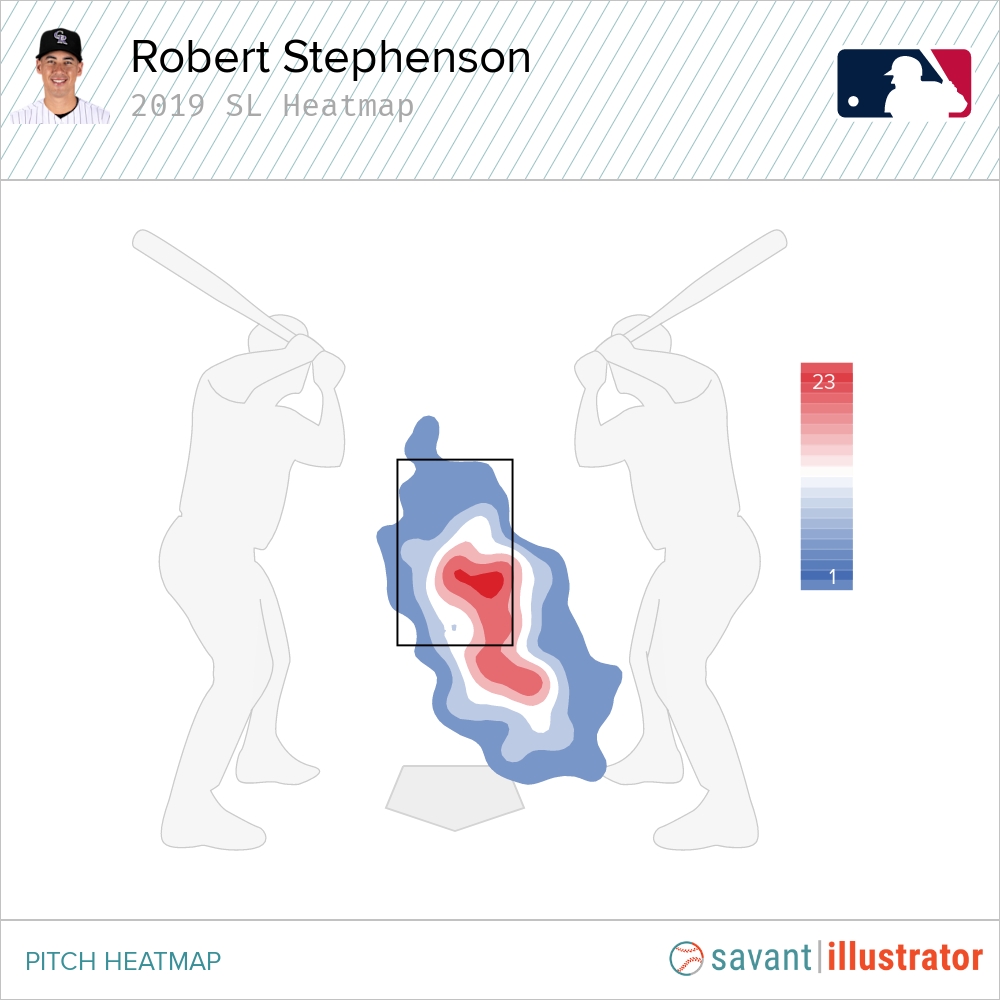
He does a good job hitting the lower glove side part of the zone, but he also does throw a lot in the middle of the zone with the pitch as well. Thus, it’s not surprising that Stephenson’s xwOBA (.204) was higher than his actual wOBA (.174) on the slider in 2019.
Now, let’s take a look at Stephenson’s slider heatmap from 2020:
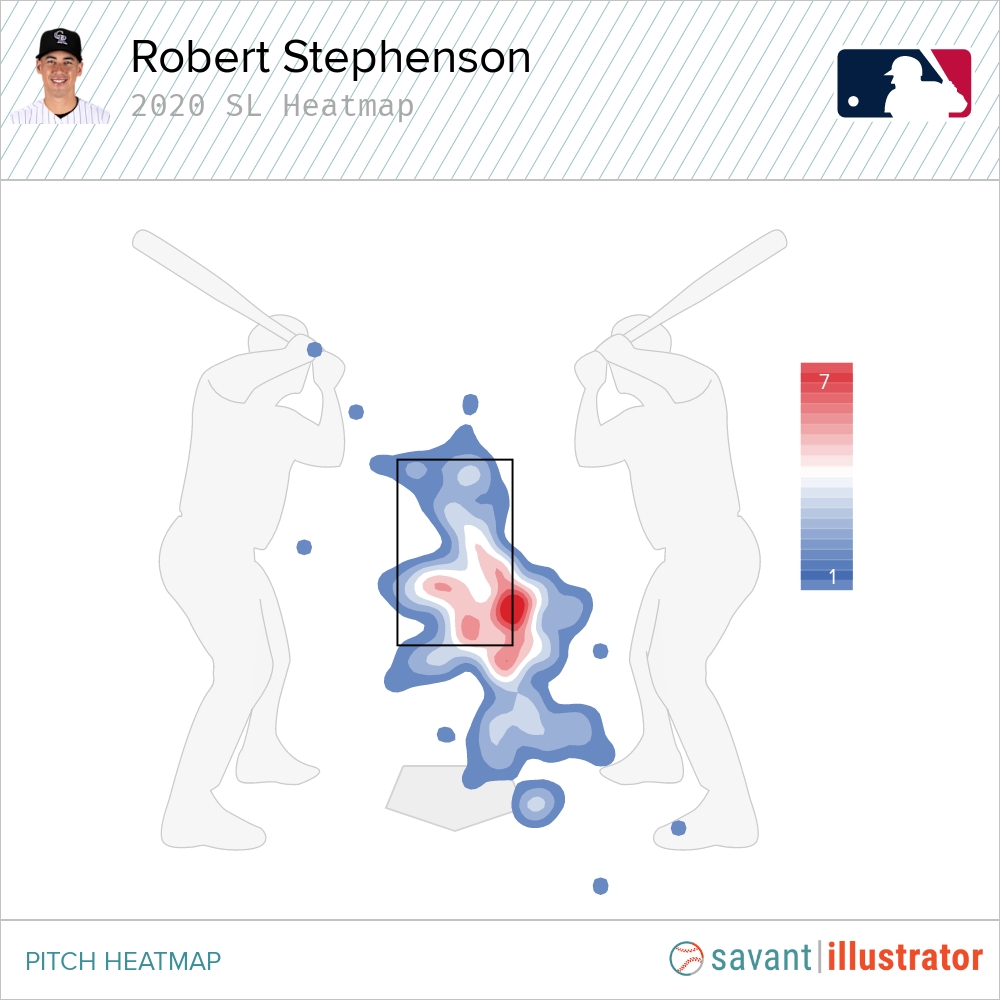
In the heatmap above, Stephenson’s hitting these 9 and 14 zones with more consistency with the slider, which is probably a better long-term sign for his slider. Furthermore, the fact that he threw his slider 12.8 percent more in 2020 than in 2019 and seemed to hit one area with more regularity is also encouraging. It even showed in two-strike counts on the pitch.
In 2020, he generated a 34.6 percent whiff rate and 28.2 percent putaway rate on two strikes with the slider, which was only a 3.6 and 2.1 difference in those categories from a year ago, respectively. Here is an example of him hitting that zone with his slider, which results in a strikeout of White Sox slugger Eloy Jiménez:
https://gfycat.com/dizzytensegossamerwingedbutterfly
Granted, while this is a smaller sample size in comparison to 2019, the fact that his wOBA (.286) was higher than his xwOBA (.200) demonstrated that he may have been not as lucky with the slider last year as he was in 2019. Thus, if that wOBA-xwOBA difference flips again in 2021 to the 2019 difference (where wOBA was lower than xwOBA), then it’s possible that Stephenson could sustain his effectiveness on his slider in his new surroundings in Colorado.
Stephenson’s Fastball Dilemma
While Stephenson’s slider has become a solid and reliable pitch the past two seasons, his four-seam fastball has been a different story. Let’s take a look at some of the data on his fastball from 2017-2020:
| Year | wOBA | Whiff% | K% | Run-Value |
|---|---|---|---|---|
| 2017 | 0.452 | 15.6 | 11.6 | 19 |
| 2018 | 0.596 | 8.1 | 0 | 6 |
| 2019 | 0.439 | 12.4 | 13.2 | 9 |
| 2020 | 0.764 | 24 | 14.3 | 4 |
Yep, these aren’t exactly metrics one wants to see from a setup man, especially one with only two or three pitches.
While Stephenson did see some gains in Whiff rate last year (from 12.4 percent to 24 percent) as well as a slight uptick in K rate (0.9 percent), hitters absolutely smashed his fastball when they made contact. Here’s a look at all the batted balls on fastballs that went for base hits in 2020:
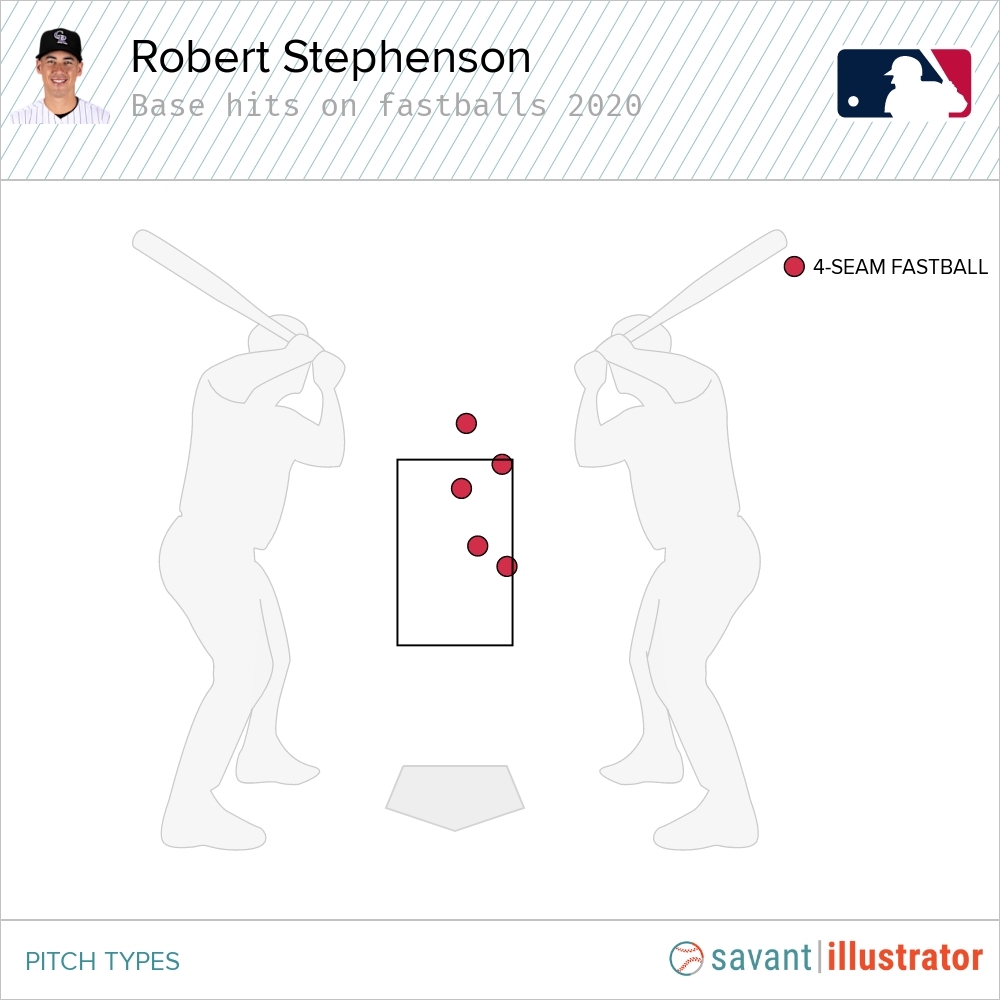
So, he gave up five base hits total last year on fastballs. Not bad, perhaps, even if it is a small sample.
However, all five of the hits he gave up on fastballs were home runs in 2020, which resulted in a 1.940 wOBA on those base hits. To make matters worse, three of these home runs on fastball came in the same inning, as the White Sox hit back-to-back-to-back home runs in a September 19th contest at Great America Ballpark:
Back-to-back-to-back home runs have left the home crowd shocked and silent in Cincinnati. pic.twitter.com/TaUko0G10l
— Chicago White Sox (@whitesox) September 20, 2020
The most interesting home run given up by Stephenson in this disastrous outing was the second one to Yasmani Grandal. Take a closer look at the GIF below at where catcher Tucker Barnhart sets up initially compared to where the pitch actually goes:
https://gfycat.com/complexlittlearcticfox
Barnhart wants Stephenson to throw it low and away, and instead, Stephenson throws it right down Broadway (much to Barnhart’s chagrin). As expected, Grandal launches it into the “virtual crowd”, and a once-close game for the Reds gets even more out of hand in the 8th inning.
The reason I brought this home run of the three up is that this pitch epitomizes Stephenson’s command issues, not necessarily ability, on the fastball. To reiterate this point, I decided to take a look at his velocity and spin metrics to see if there was a trend that could give more information on why his fastball has been such an unreliable pitch for Stephenson over the course of his career.
Here’s what I uncovered:
| Year | MPH | Spin |
|---|---|---|
| 2017 | 93.5 | 2355 |
| 2018 | 93 | 2296 |
| 2019 | 94.5 | 2422 |
| 2020 | 95 | 2494 |
Based on the table above, the velocity and spin metrics look promising. His velocity has pretty much increased every year since 2018 and his spin rate has jumped as well, as there is a near-200 point difference in spin from 2018 to 2020. Furthermore, his 98 percent active spin on the fastball would rank him in the upper percentiles of the league on the pitch.
And yet, the fastball continues to get hit hard over the course of his career.
Thus, the main explanation or takeaway that can be had is that Stephenson’s command on the pitch is middling at best. Stephenson is leaving it in easy-to-hit zones, and hitters have taken advantage. Here is a look at his fastball heatmap over the past two years, according to Savant:
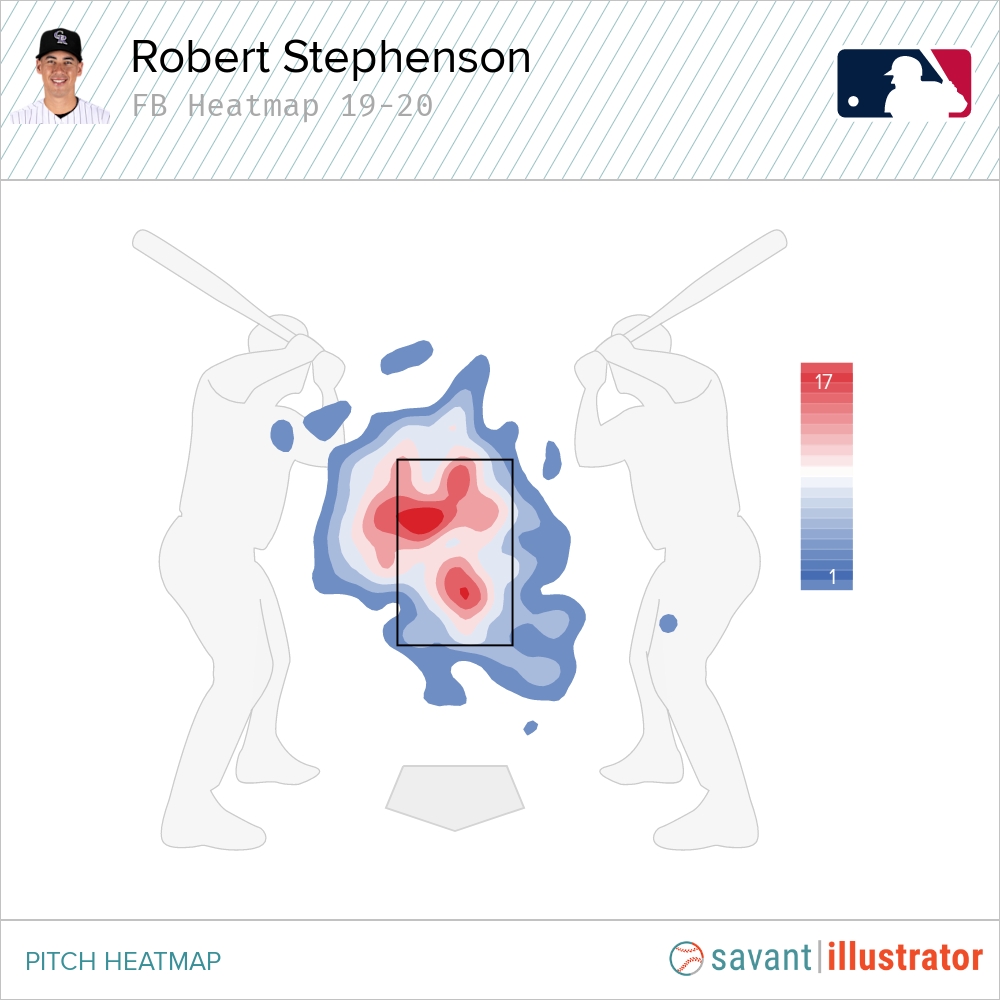
On the other hand, here is a zone wOBA chart that shows how hitters have fared against his fastball over the past two years. Pay attention to zone 1-4 and 5-8, where there are deep red areas on the contour:
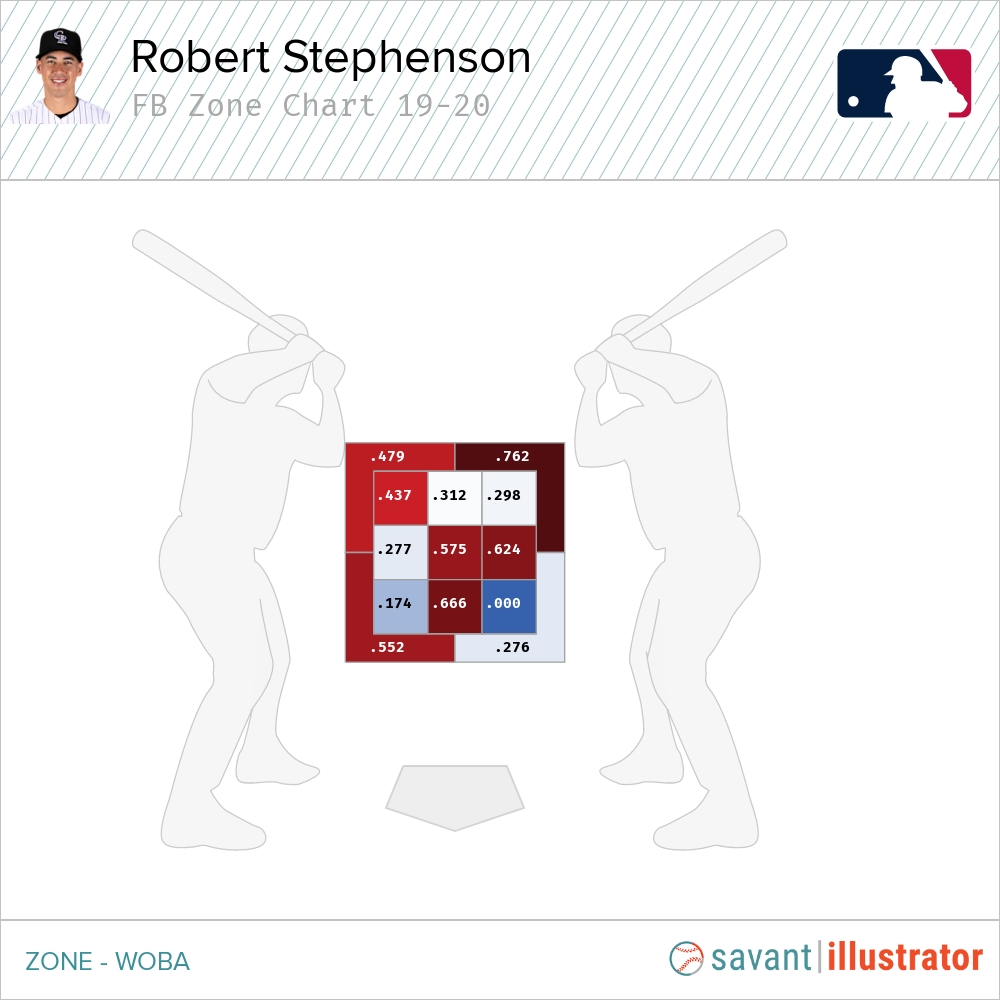
As one can see from the comparing charts, Stephenson is getting killed in zones where he throws his fastball the most. If he wants to improve his outlook as a reliever in Colorado, his fastball command is going to need some tweaking, and it will be interesting to see if Rockies pitching coach Steve Foster will be able to help Stephenson in this area this Spring.
What is Stephenson’s Outlook in 2021?
Interestingly enough, Stephenson will be battling with former top prospects Bard and Mychal Givens (formerly of the Orioles) for the closer’s role in Colorado next year. Bard obviously will have the advantage, as Bard saved six games last year and posted a 3.65 ERA and 3.98 xERA in 24.2 IP. That being said, while Stephenson is the new face in the clubhouse, it is possible that Stephenson could slide into the role in the ninth, especially if he can figure out his fastball issues.
I decided to take Stephenson, Bard, and Givens’ past two years of plate discipline data from both Fangraphs and Alex Chamberlain’s Tableau. Below is a table of the plate discipline data I was able to generate and organize in regard to the three potential Rockies closer candidates:
| Name | O-Swing% | Contact% | F-Strike% | SwStr% | CSW |
|---|---|---|---|---|---|
| Robert Stephenson | 36.6% | 62.0% | 62.3% | 18.9% | 35.6% |
| Daniel Bard | 32.3% | 73.3% | 57.5% | 12.9% | 32.0% |
| Mychal Givens | 31.8% | 69.9% | 57.2% | 15.0% | 30.6% |
When compared to Bard and Givens, Stephenson looks a lot more impressive, as he was the best out of the three in terms of generating swings outside of the strike zone, contact rate, first-strike percentage, swinging-strike rate, and CSW over the past two seasons. Thus, it makes sense that the Rockies acquired Stephenson from Cincinnati, as they perhaps believed a move westward could help Stephenson tap into his closer potential in 2021, and maybe beyond.
Of course, Stephenson has to stay healthy and work on that command of his fastball, both of which have plagued him over his career. He’s pretty much a two-pitch pitcher at this point, as the only other pitch he throws is a splitter, which he threw only four percent of the time in 2020 and seven percent of the time in 2019. That being said, his slider is really impressive, and his fastball has the velocity and spin potential to be a decent pitch, which is maybe all he needs at this point in his career.
It was a rough end for Stephenson as a Red, and Cincinnati was probably in the right to trade him last November. Let’s see though if the Rockies can help Stephenson in 2021, much like they did with Bard in 2020. If they are able to turn around Stephenson next year like Bard last season… Well let’s just say the Rockies bullpen may be one of the more underrated ones in the league. Stephenson could be a hot commodity by next year’s trade deadline, which should interest potential fantasy owners looking for a breakout closer candidate next year (since Coors Field isn’t exactly a pitcher’s paradise). The Rockies aren’t going anywhere soon in the NL West, and just imagine what Stephenson could do in a pitcher-neutral ballpark.
Photos by Adam Bow / Icon Sportswire | Design by Quincey Dong (@threerundong on Twitter)

